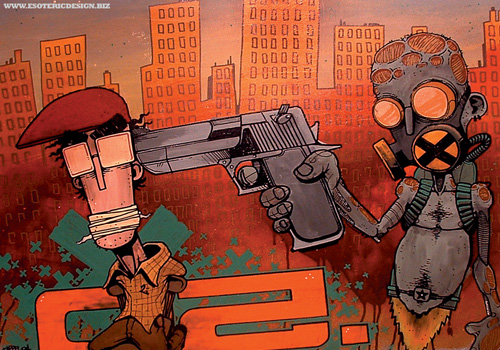1000 Styles and Counting
Local artist Dan Dippel brushes on the city grit

By Alex Suskind : Illustrations by Dan Dippel
I am looking at an image of a man/beast-like creature hunched over as drool oozes out of his teeth. His hands are hovering over his head and his fingertips slightly scratch the surface of his skull. Planted on top of this zombie-looking beast are several transmission line towers. A “High Voltage” sign is barely visible in the background. Is he frightened? Is he in pain? The beast’s cranium looks as though it is generating electricity. Or, maybe the transmission line towers are the ones producing the voltage, electrocuting the creature into a state of paralysis. Perhaps this image has an infinite number of meanings -— the “it is whatever you think it is” explanation.
The man behind this piece, entitled Tastes Like Chicken, is an artist by the name of 1000styles, aka Dan Dippel. His body of work explains the meaning behind this alias. Dirty factories, towering mushrooms, and Leatherface from The Texas Chainsaw Massacre are just some of the images that appear in his art.
“I use the alias 1000styles because I try to keep my art from becoming characterized by any certain term or definition,” Dippel said. “That is pretty much my one rule, that I will never do the same thing twice. Never do something that doesn’t push the envelope [or] push the boundaries of what’s comfortable for me.”
Dippel’s dynamic life has influenced his spectacularly bizarre artwork. He grew up in Walworth, N.Y., a small, rural town 30 minutes east of Rochester. The urban themes you see in Dippel’s art today were absent from his earliest designs.
“When I was real young, it was all about monsters,” he said. “Then I got really into comic books [during the] grade school era up through high school,” Dippel said.
In the fall of 1996, Dippel arrived at Syracuse University to study illustration. It was in Syracuse’s urban environment where his ideas began to take shape.
As his work slowly transformed, Dippel immersed himself in the local music scene, attending everything from hardcore concerts to drum and bass parties. He began collecting flyers promoting these shows and eventually developed relationships with people in those different scenes.
Word got around about Dippel, and he began to design flyers for the shows and parties that he was attending. The project led to the creation of Esoteric Design, a freelance art business. The name “Esoteric” came from a party he went to in college, and figured the idea of exclusivity fit his artistic principles.
“[My art] is kind of off the beaten path, and unless you are off the beaten path in that same way, you are not going to fully understand or appreciate it,” Dippel said.
As Dippel continued to design flyers for shows, he moved out of the dorms and into one of Syracuse’s lower-class neighborhoods. The move affected him tremendously.
“You wouldn’t think someone would enjoy moving to the ghetto, but I thought it was great,” Dippel said. “Coming from where I came from…there was such a complete immersion into a completely different culture. Just the visual aspects of everything that was going on around me and everything that I saw on a daily basis really had a huge effect on where my art was going and who I was as a person.”
While still taking classes at SU, Dippel met his future wife, Claudia, then a student at SUNY College of Environmental Science and Forestry. Claudia, whose mother was an artist, was impressed the first time she saw Dippel’s work.
“The detail in his traditional watercolor and line work were just really, really incredible,” she said. “I hadn’t seen somebody so young be so developed in traditional illustration.”
When he graduated in 2000, Dippel faced the inevitable job quest. He began building the Web site for Esoteric Design (www.esotericdesign.biz).
While working as a graphic designer at SUNY Upstate Medical University, he continued to expand his freelance business, designing T-shirts, hats, and album artwork. Esoteric grew as he worked for clients across the country, and soon, all over the world. Remarkably, he made a name for himself without spending any money on advertising.
On top of his eight-to-nine-hour workdays, Dippel continues to work for clients through Esoteric. Yet he enjoys the stress that comes with being an artist.
“I will be in the middle of creating a piece, and from the time I start the final version until I put the paintbrush down…it’s constant incredible stress in my head,” Dippel said. “With art, there is a starting point and an infinite number of endpoints that can be just as successful as any of the ones next to them. That stress of choosing which direction to go at every second of the way is a huge load on my brain. But I enjoy it at the same time —- it’s unexplainable. When the piece comes out well, it’s like a huge load off my head and it’s a great feeling.”
This time, I am looking at a different image, depicting a man gagged and kneeling on the ground. The man has a skinny head, a red beret, and square-shaped glasses with thick white lenses perched atop his long nose. A Desert Eagle is pressed against the man’s head by a mutant-looking figure. The gas mask planted on the mutant’s face suggests a post-apocalyptic world. The city skyline in the background glows a faint orange, as if a setting sun was reflecting off the skyscrapers.
This piece, called 50, is exceptionally different from Tastes Like Chicken. After all, there is a reason the man who created both works is named 1000styles. The artist is, without a doubt, living up to his title.
